7 Reproduction: Amphibians
Living a Double Life
The word Amphibian means double-life which in reference to the typical life-cycle of amphibians which alternates between an aquatic larva and a terrestrial adult.
An amphibian typically starts its life as an aquatic egg. Amphibian eggs lack a hard shell and the embryo is surrounded only by a few layers of a highly permeable gelatinous material. Amphibians eggs thus dry out rapidly and must be laid either in water on in a moist environments. The egg hatch into an aquatic larva which will eventually metamorphose into a terrestrial or semi-terrestrial juvenile looking like a smaller version of the adult. As adults, amphibians typically live on land and return to the water to mate and lay their eggs.

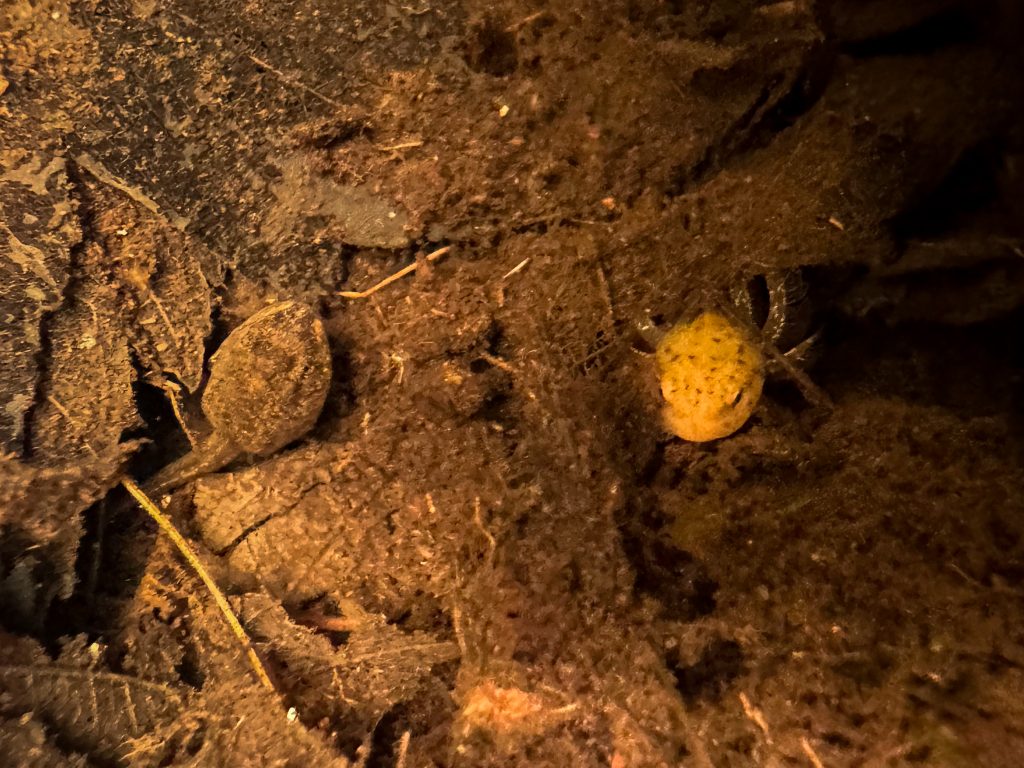
Compared to amniotic eggs, amphibian eggs hatch relatively quickly and much of their development occurs outside the eggs as a free-living larva capable of feeding on its own. Therefore amphibians eggs are provisioned with little resources compared to amniotic eggs. Larval amphibians get their energy and nutrients straight from the environment while embryos inside an amniotic eggs rely on resources packaged inside the egg by the mother. Amphibian eggs are thus smaller, and cheaper to produce than amniotic eggs. Most species of amphibians lay hundreds to tens of thousands of small eggs. For instance a single American toad female can lay up to 20 000 eggs. Not all amphibians are this fecund thought. For instance a female four-toed salamanders lays only about 20 eggs but unlike most amphibians, this species provide some parental care. For most part, however, reptiles which are amniotes, lay far fewer but much larger eggs than amphibians of similar size.
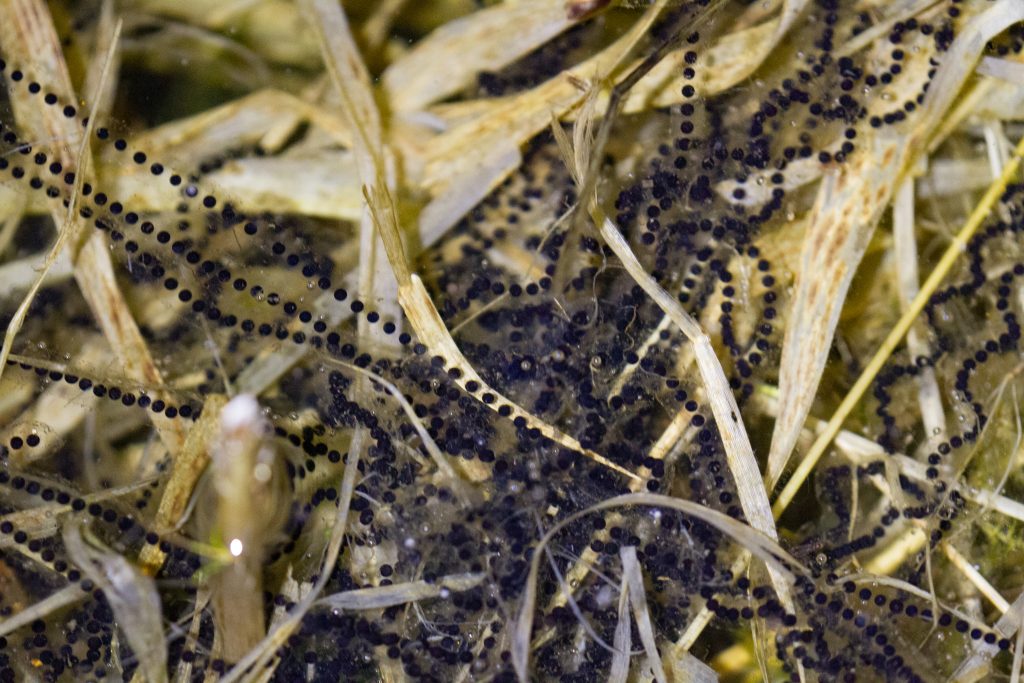
In Canada, most species of frogs and salamanders have an aquatic larva and a terrestrial or semi-terrestrial adult which is the ancestral state in the class Lissamphibia. However many species have deviated from this ancestral life-cycle to suit certain environments.
For instance the European fire salamander (Salamandra salamandra); which is fact a newt (i.e. a member of the family salamandridae) has evolved two different kinds of live-birthing (viviparity). In most populations of the species, females give birth to 30 to 60 small larvae. The females retain the eggs internally until they hatch. The eggs receive no nutritional input from the mother other than the yolk provisioned into the eggs. In some populations of fire salamanders however, females took viviparity a step further and give birth to 1 to 15 fully formed juveniles. In these populations, eggs rapidly hatch inside the uterus and the embryos receive some nourishment from the mother but also cannibalize aborted eggs and even smaller siblings inside the wound! Thanks to these additional sources of nutrition, the embryos rapidly go through their larval stage inside the mother which gives birth to fully formed juveniles.
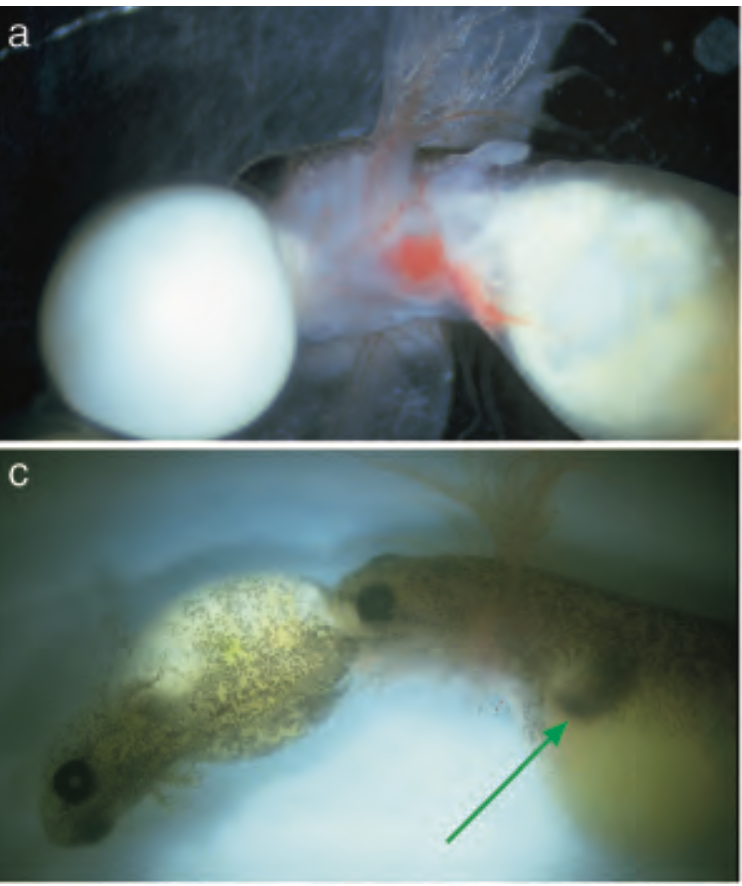
Some species of amphibian retain egg laying but have the larval stage occurring entirely inside the egg. This strategy eliminates the need to lay eggs in water and allow these species to lay eggs on land albeit in very moist and cool areas. This is the case in the red backed salamander (Plethodon cinereus). In this forest salamander, females lay their eggs inside rotting logs. The eggs hatch into tiny but fully formed terrestrial salamanders that are the length of a fingernail!
The Coqui (Eleutherodactylus sp), a puny tree frog native to Puerto Rico and a few other islands also have its tadpole stage entirely inside the egg. Females lay their eggs in moist areas on land. The eggs hatch as fully formed froglets. This trait contributed to the Coqui’s success as an invasive species. Coqui’s have been introduced to many areas including the Hawaiian Islands. Many came inside potted plants imported from the Coqui’s native’s range. In Hawaii, they have reached the highest density of any amphibian species in the world.
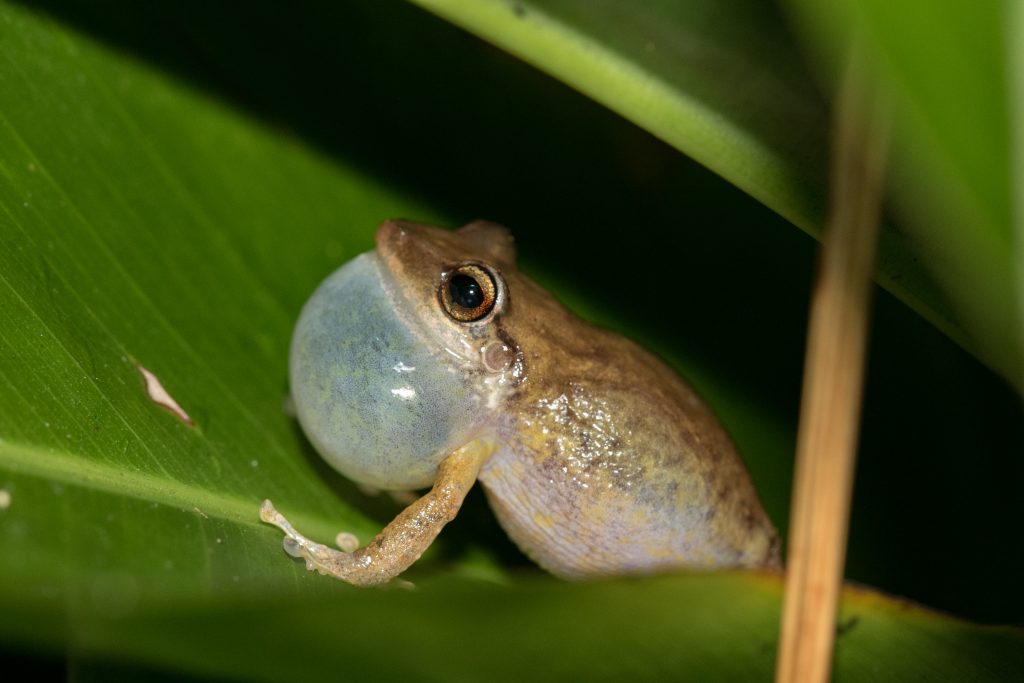
While some species complete their entire life cycle on land, other species never set foot on it. This is the case for instance of the mudpuppy (Necturus maculosus). This salamander never undergoes metamorphosis and matures while retaining many larval traits including external gills: a phenomenon called paedormorhosis. Nine of the ten families of salamanders include paedormorphic species. In three families, all species are obligatory paedomorphic (proteidae, amphiumidae, sirenidae). Other families may have obligate and facultative paedomorphic species.
The red-spotted newt (a.k.a. eastern newt) has an unusual life-cycle for an amphibian. The adult newt is a fully developed adult lacking gills but lives in water. Adult red spotted newts mate and lay their eggs in water and the eggs hatch into gilled larvae. So far, it is pretty much a typical amphibian life-cycle but things take an unusual turn when the larvae metamorphose. Instead of turning into an immature version of an adult as in most salamanders, the newly metamorphosed newt enters a stage intermediate between the larva and the adult called the red eft. Red efts live on land do not look like the adults. As their name implies, red efts are bright red or orange, while the adults are green to brown. Red efts also have a rougher looking skin. Adult red spotted newts have a laterally compressed tail that they use as a fin. Red efts have a much shallower tail. The red eft stage can last several years. Efts eventually undergo a major morphological transformation to become an adult that will migrate back into the water to reproduce. The adults can remain in the water or migrate back onto land after their reproductive season. If they migrate back on land, they partially re-acquire a terrestrial morphology.
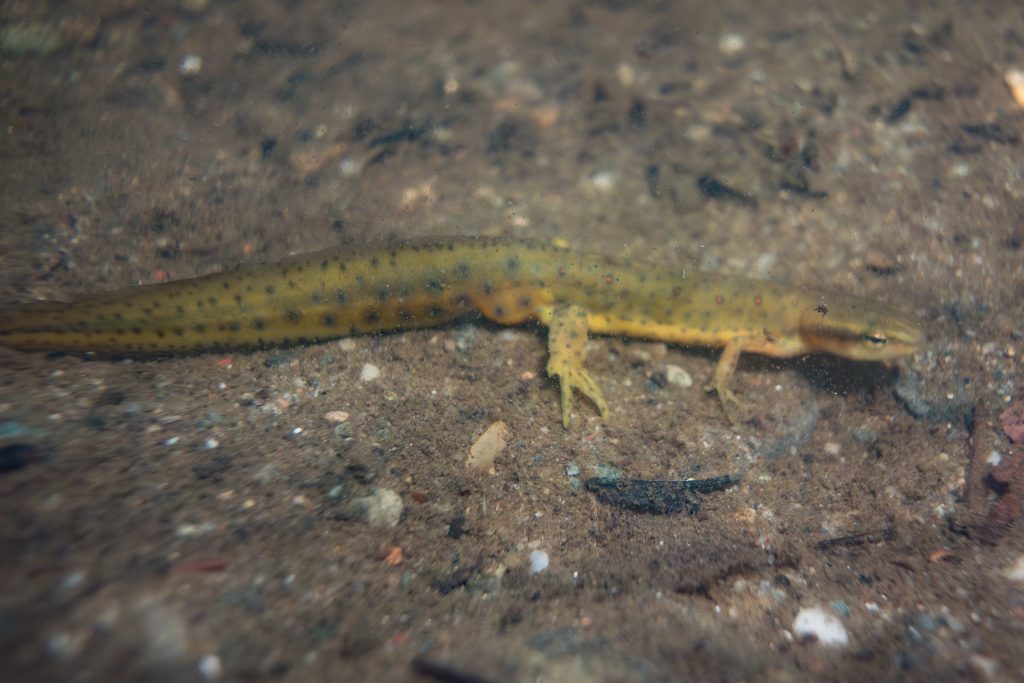
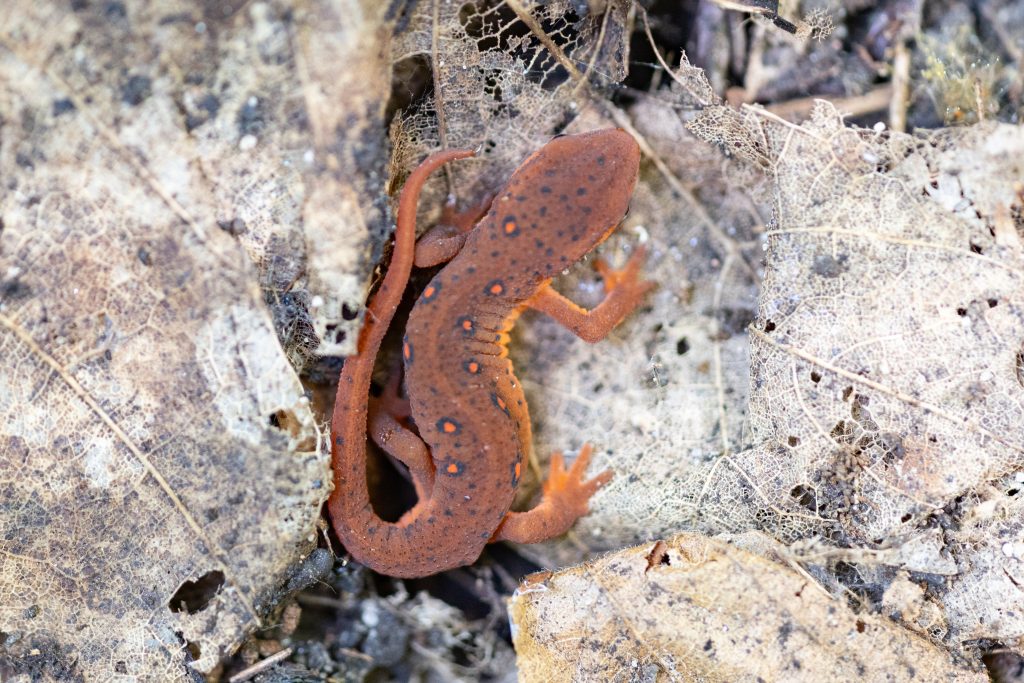
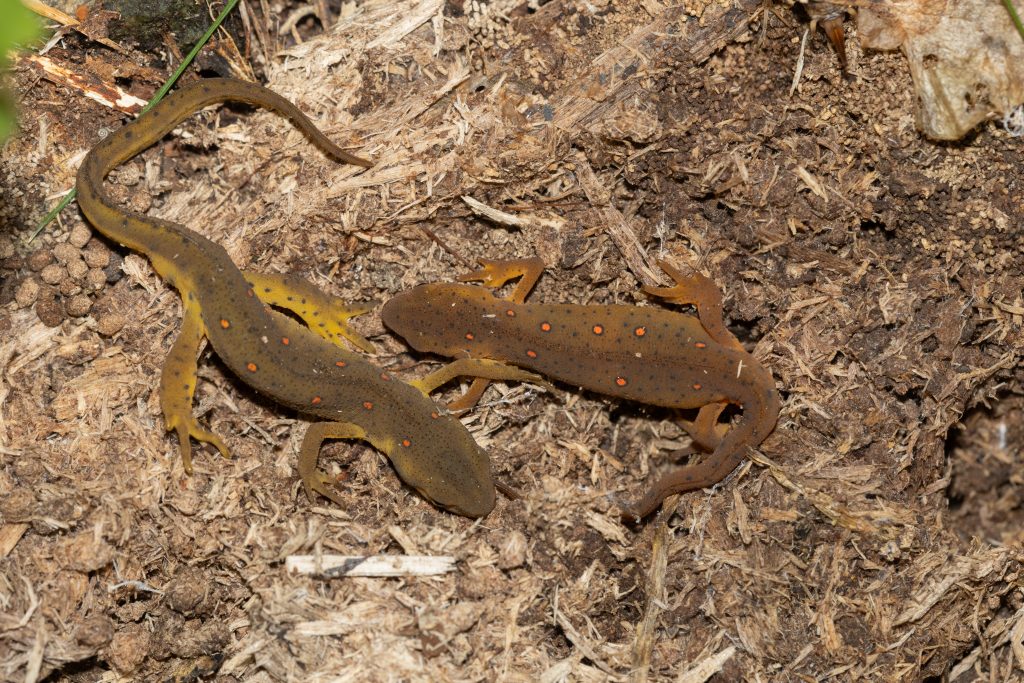
Mating Season
In Ontario most frog species breed exclusively in the spring. The American bullfrog and the green frog have mating seasons that extend well into the summer though. Frogs have external fertilization so mating and egg laying must occur at the same time. In salamanders, fertilization is internal so mating and egg laying may occur at different times. In spotted and blue spotted salamanders, mating and eggs laying occur at the same time and in the early spring. Red-backed salamanders, four-toed salamanders, two-lined salamanders, and mudpuppies are all known to mate in the fall but eggs laying does not occur until the following spring or summer.
Rainfalls and temperature trigger hormonal cascades which themselves trigger reproductive morphology and behaviour. Many species of amphibians breed in temporary wetlands which get their water from snow melt and rainfalls. In years of low precipitations, these ponds may dry out before the larvae have completed their development.
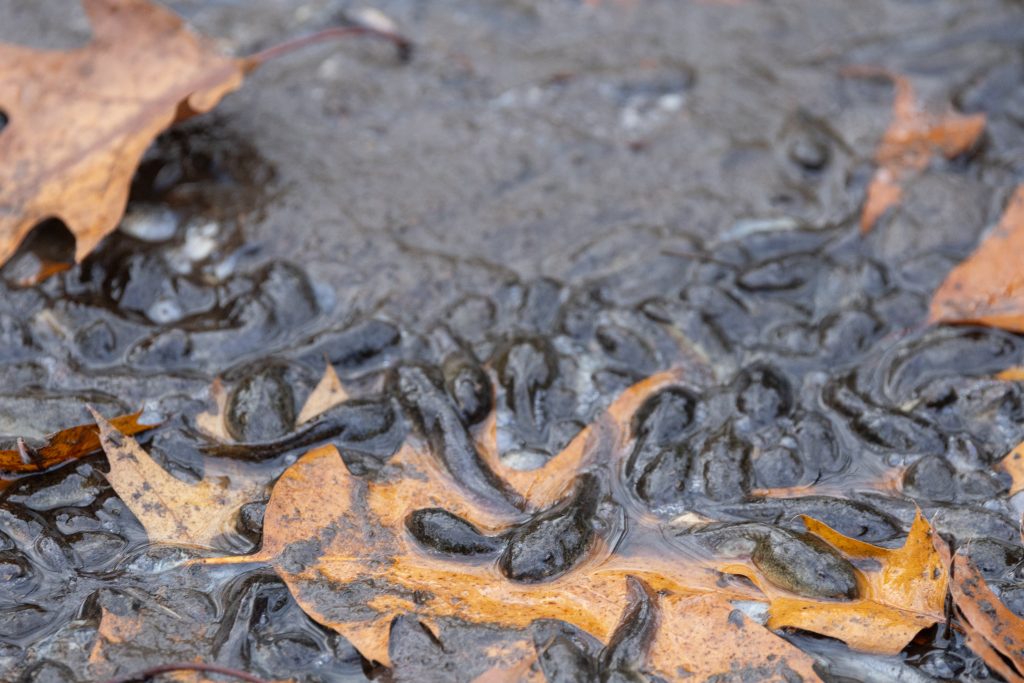
Rainfalls are important for the migration of amphibians to their breeding ponds. Most species migrate to their breeding ponds during rainy nights. Mass migration to breeding ponds makes certain species vulnerable to road mortality.
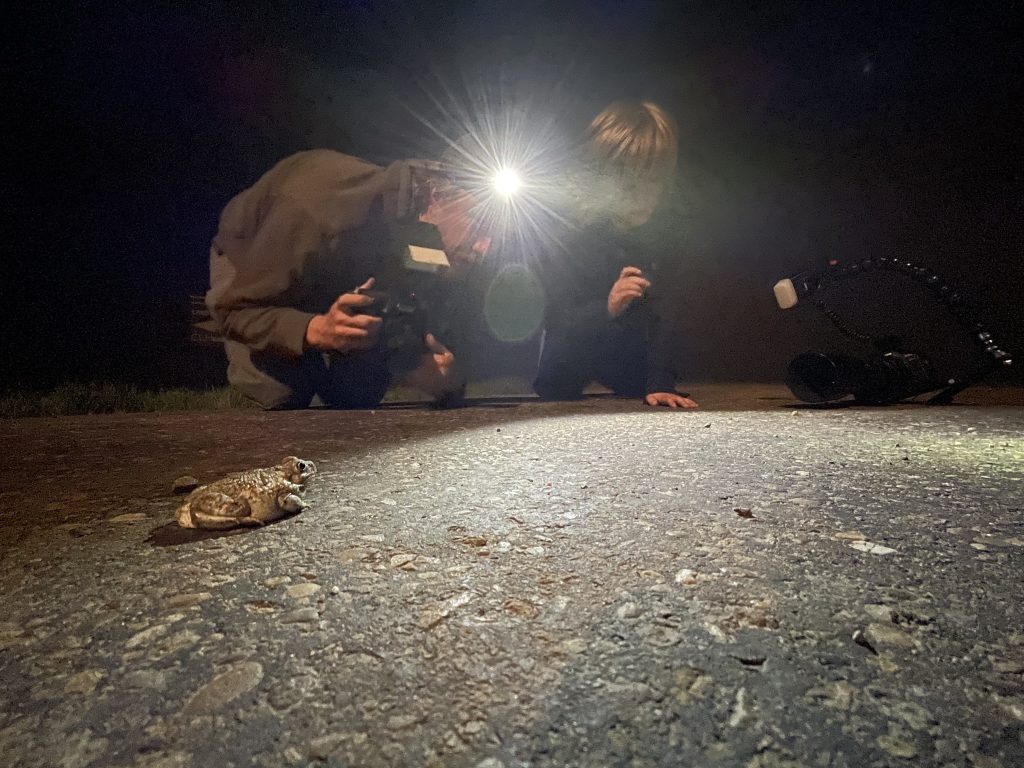

Sexual Selection & Mating
Frogs
Intersexual selection, or female choice, is prevalent in frogs in which males call to attract females, and females select males based on the characteristics of their calls (see section on vocalization below). However intrasexual and intersexual selections are by no means mutually exclusive and often occur simultaneously. In most frog species in Ontario, males compete for mates (i.e. intrasexual selection) in messy races for mates called scrambles. Scrambles occur when several males try to access a pool of females at the same time but without fighting one another. Scrambles typically do not involve mating territories or mate guarding. Scrambles are common in species that have are have short breeding seasons and that are aggregated during their mating seasos (so called explosive breeders). America toads, gray tree frogs, spring peepers, chorus frogs, and wood frogs have short and intense breeding seasons characterized by scrambles. Scrambles can be intense, and several males will often simultaneous try to mate with the same female potentially causing arm to the female.

Most frog species, including all species in found in Ontario, have external fertilization. One notable exception is the tailed frogs found in western Canada. The “tail” in this species is in fact a copulatory organ. This species breeds in fast flowing streams in which sperm would get washed out quickly if released directly on the eggs.

External fertilization means that male and female must synchronize the release of sperm and eggs. To do so, the male clasp the female in a position called amplexus. Various types of amplexus exist based on the position of the males relative to the female. All species in Ontario engage in axillary amplexus in which the male is on the back of the female and wraps its forelegs just behind the female forelegs. In many species, males develop enlarged thumbs with rough patches of skin called nuptial pads which help them clasp the female during amplexus.



In species in which males compete in scrambles, several males may try to engage in amplexus with the same female which can be lethal for females. In the European common frog (Rana temporaria), some females avoid these hazards by playing dead.
Some species are territorial and males fight with one another to keep intruders out of their territory. This is the case for instance in the green frog and the American bullfrog. These species are typically found in permanent water bodies and have a longer breeding season than the species listed above. Males establish territories for females to lay in and they defend their territories against other males. Research on American bullfrogs showed that males learn to recognize the calls from males of adjacent territories and react less aggressively to them than to the calls of unknown males.
Salamanders
The mating behaviours of salamanders also combine intra and intersexual selection. Salamanders have internal fertilization but lack an intromittent organ. Sperm is transferred to the female via a small stalk of gelatin caped with sperm called a spermatophore.

Males deposit the spermatophores at the bottom of water bodies or on the forest floor (in the case of fully terrestrial species like Plethodon sp) and the females pick up the spermatophores with their cloaca. The male courtship in salamanders is often an elaborate affair in which the male guide the female to their own spermatophores. Females presumably select males (intersexual selection) based on tactile or chemical cues communicated during courtship.
Chemical communication appears important in the mating behaviour of salamanders. In some species, males have glands that secrete hormones increasing the receptivity of females. In red-spotted newts, males have glands located on both sides of their head called genial glands. During courtship males, rub these glands on the female’s skin. The hormones then enter the female’s blood stream vias the skin (remember the skin of amphibians is highly vascularized and permeable). To rub its genial glands on a female, a male clasps the female with its enlarged hind legs , the inner surface or which is dotted with patches of rough skin that provide grip.


Male plethodontids have a mental gland on their chin. The glands becomes enlarged during the mating season. During courtship, a male rub or tap their mental gland on the female’s skin. In some species, males have elongated upper teeth protruding through their lower jaw. When a male rubs its mental gland on the female’s back, the teeth scratch the female’s skin which helps hormones entering into the blood stream.
Although it is clear that chemical cues play a role in the courtship and mating or salamanders, it remains unclear if these chemicals are used by females to select mates or if they have a coercive function.

Spotted and blued-spotted salamanders are explosive spring breeders. These species are in fact often found in the same breeding ponds as wood frogs, spring peepers and gray tree frogs. As in these frogs species, the males of spotted and blue-spotted salamanders compete with one another in scrambles (intersexual selection). It is not rare to observe tangles of males spotted salamanders attempting to mate with the same female. The males do not appear to be aggressive towards one another.
The use of spermatophores in salamanders opened the door to sexual interference between males (another form intrasexual selection). In some species like the spotted salamander (Ambystoma maculatum), males “parasitize” the spermatophores of other males by depositing their own spermatophores on top of of those of their rivals. By doing so, they may be able to fertilize eggs without investing time and energy in courtship.
In some salamanders, males maintain territories and fight with one another. In red-backed salamanders, males aggressively defend territories. Plethodontid salamanders have a channel between their nostril and the margin of their upper jaw. This channel, called a naso-labial groove is more developed in males and extends below the lower jaw which gives males a more boxy snout compared to females which have a rounder snout. The naso-labial groove delivers chemicals dissolved in the environment to the vomero-nasal organ located in the nasal cavity. This organ is also more developed in males. This system helps salamanders locate potential mates and rivals. When a male red-back salamander encounters another male, a fight may ensue in which the opponents bite each other. Bites are often directed at the head and at the naso-labial grooves. Injuries to this area can interfere with a male’s ability to locate mates and defend its territory.

Vocalization in Frogs
Frogs are by far the loudest of all herps. Calling serves different functions in frogs but advertisement to females is the primary function. Indeed, males generally have a much more developed calling apparatus than females. The calling apparatus of frogs is derived from the respiratory system. Sound is produced as air flows through the larynx housing the vocal chords. The larynx is located between the lungs cavity and the buccal cavity. The buccal cavity opens into a pouch in the throat area called the vocal sac. During calling, the air moves back and forth between the lungs and the vocal sac. Powerful trunk muscles contract to force air out of the lungs, through the larynx, and into the vocal sac which inflates like a balloon.

The vocal sac serves two main purposes. First it amplifies and thus help broadcast the sound. Frogs with larger vocal sacs tend to be louder than those with smaller ones. Second, it helps move the air back to the lung cavity through elastic recoil. The size and position of the vocal sac varies between species. Some species have a single median sac while others have two lateral sacs.

Calling is a high intensity exercise. For instance, a spring peeper can peep 3000 times per hours and can do that over several hours. Moreover, peepers are extremely loud. Their call can reach 90 db from a distance of 50 cm distance which is equivalent to a human shouting as loud as they can. Imaging shouting 3000 times per hour for 3 hours straight!
Calling is very energetically demanding indeed. The metabolic rate of a calling male gray tree frogs can be 15 times greater than its resting metabolic and equivalent to the cost of locomotion. Male frogs have larger trunk muscles than females and their muscles have a higher concentration of mitochondria, and a higher density of blood vessels which allows them to use their aerobic metabolism to sustain their calling activity. In some species of frogs, females prefer males producing high intensity calls. Since there is a direct relationship between call intensity and energy expenditure, call intensity is considered a honest signal of male quality in many species of frogs.
Egg laying
Egg laying in most species of amphibians occurs in the water. In Ontario, exceptions are the red-backed salamander and the four-toed salamander. As mentioned above, the larval stage of the red-backed salamander occurs entirely inside the egg. In contrast, the four-toed salamander has an aquatic larva. The eggs are deposited in sphagnum moss overhanging water. Upon hatching, the larvae drop in the water.
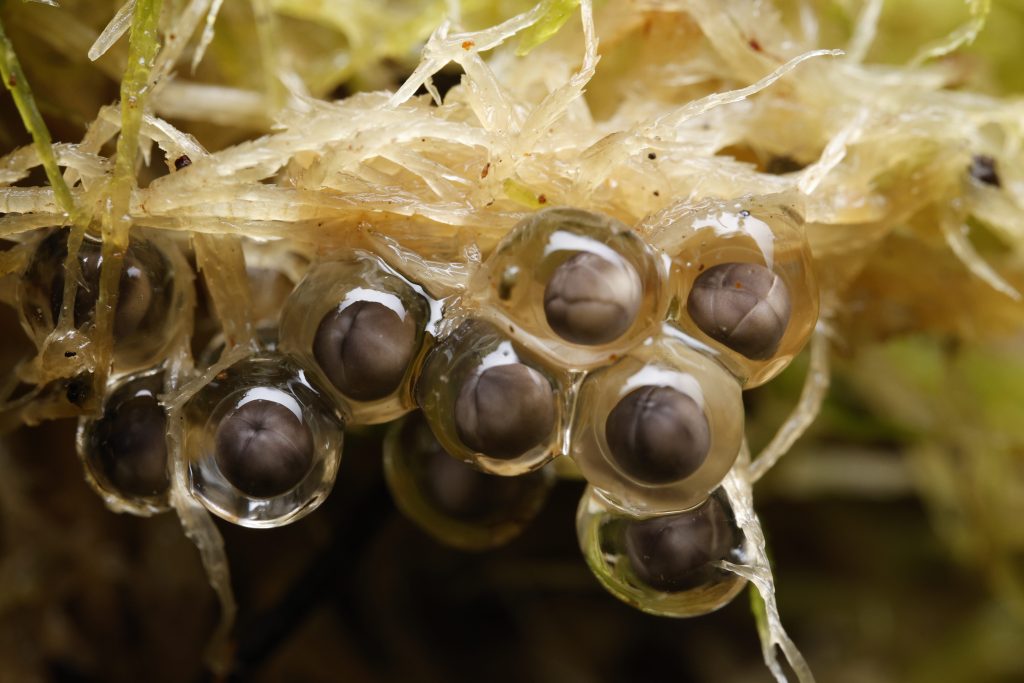
Some species of amphibians lay their eggs communally as it is the case in the wood frog and the four-toed salamander. Communal egg-laying may occur simply because suitable egg-laying habitats are scarce, but it may also have some benefits. Laying communally may reduce the risks of depredation, and may buffer the eggs against environmental fluctuations. Females may also benefit by laying their eggs communally if doing so reduces the time or energy costs of searching for a suitable site.

Larval Stage and Metamorphosis
Salamander larvae are superficially like adults but have external gills and a laterally flatted tail with a dorsal and ventral fin. The most obvious differences between frog and salamander larvae is the absence of limbs (except in late developmental stages) and external gills in tadpoles.

Like fish, tadpoles also have a lateral line which is a series of mechano-receptors running along the side of the body. In tadpoles, the gills are inside the pharyngeal cavity. During gill ventilation, water enters the mouth, flows over the gills, and exit the body through a special opening (or pair of openings) called a spiracle.

The larval stage is the ancestral condition in all animals, and amphibians are the only tetrapods to have retained this condition. A larva can be described as a feeding machine designed to acquired energy and nutrient to build biomass. Amphibian larvae are generally aquatic and often exploit highly productive aquatic habitats such as vernal (temporary) ponds and other small wetlands.
In salamanders with a terrestrial adult, the gills and tail fin disappear upon metamorphosis but some species retain their gills, and other larval traits into adulthood. This condition is called neoteny and can be obligate as in the case of the mudpuppy (Necturus maculosus) and other members of the Proteidae family or facultative as in the case of the axolotl and other members of the genus Ambystoma. In such species, metamorphism appears to be determined by a combination of genetic and environmental factors including water chemistry and hydroperiod.

The most obvious changes occurring during metamorphosis in salamanders concern the breathing and feeding apparatus. In species with terrestrial adults, gills are completely resorbed, and the gill opening shut.
Salamander larvae feed by suction (see unit on feeding) which is not possible on land. As part of their metamorphosis salamanders develop a large fleshy (and sticky) tongue to capture prey on land. The epidermis also thickens presumably to reduce evaporative water loss on land.
Metamorphosis is most dramatic in frogs in which a limbless, gill-breathing, herbivorous fish-like creature turns into a terrestrial predator with massive limbs and lungs in a matter of days. Frog larvae are in fact so different from the adults that we don’t call them frogs. We call them tadpoles. Tadpoles need to develop lungs, limbs, jaws, teeth, eyelids, a tongue, and a new digestive system among other traits.
In 1960, Kenneth Gosner described 46 developmental stages from embryo to froglet that are now called Gosner stages. Each stage is characterized by specific features (a similar system exists for salamanders as well).
The duration of the larval period can vary dramatically between species of amphibians. Salamanders in Ontario have a relatively short larval period and metamorphose in the same year they were born.
Many species of frogs also metamorphose rapidly. For instance, the American toad can go from egg to toadlet in only 60 days. Some spadefoot toads (Scaphiopus, and Spea) may take only 8 days to metamorphose! On the other hand, the American bullfrog (Lithobates catesbeiana) may remain a tadpole for 2 or 3 years.
Interspecific variation in the duration of the larval period reflects adaptations to hydroperiod. Spadefoot toads, including the Plains spadefoot (Spea bombifrons) and the great basin spadefoot (Spea intermontana) toad found in western Canada live in deserts and breed in ponds with very short hydropedriods. In contrast, the American bullfrog typically breed on the margin of large permanent ponds, lakes and rivers.
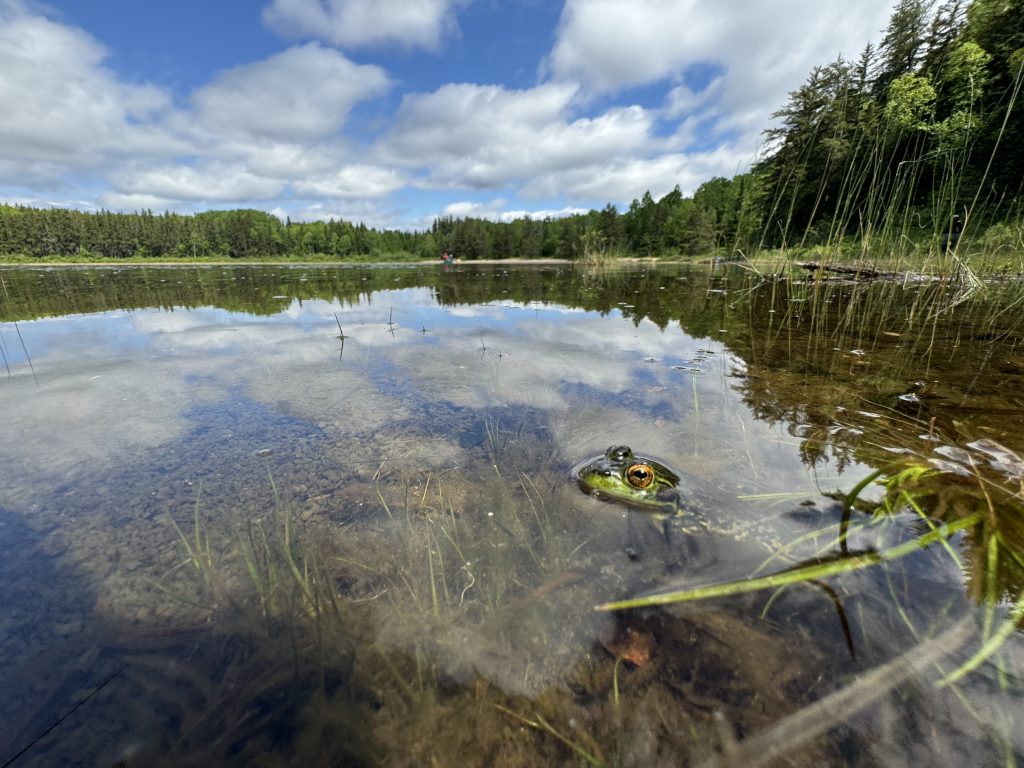
Many species of amphibians in Ontario breed in temporary (i.e. vernal) ponds. These ponds can make excellent habitats for larval growth as they are typically warm (allowing for rapid development), productive, and often free of predatory fish.
Temporary ponds are also challenging environments because, as their name implies, they sometimes dry out and their hydroperiod can vary greatly from year to year. As a pond dries, its temperature increases and dissolved oxygen decreases. The density of larvae also increases and so as competition for resources.
Many species of amphibians can adjust their development (developmental plasticity) to cope with unpredictable hydroperiods. When their pond is drying rapidly, larvae spend less time at each developmental stages and can thus metamorphose earlier. This strategy does not appear to be without costs however as rapid metamorphosis can translate into smaller body size in newly metamorphosed amphibians and reduced survivorship.
Henry Wilbur and James Collins (1973) developed a model of larval development and metamorphosis. They surmised that metamorphosis can occur only within a certain size window bracketed by a minimal and maximal size. If conditions for growth are good, metamorphosis will occur near the maximal size. If conditions are poor, say because of high competition, metamorphosis will occur near the minimal size.
The tiger salamander (Ambystoma tigrinum) shows an interesting type of developmental plasticity in response to pond drying. When density increases because of pond drying pond, some individuals change their head and mouth morphology and start feeding on their conspecifics. Interestingly, the cannibals appear to discriminate against their kin when feeding on conspecifics. Similarly, in some populations of spadefoot toads, the tadpoles have two possible phenotypes: small and omnivorous or large and cannibalistic. Which phenotype is better depends on the environment.
References
Buckley, David & Alcobendas, Marina & García-París, Mario & Wake, Marvalee. (2007). Heterochrony, cannibalism, and the evolution of viviparity in Salamandra salamandra. Evolution & development. 9. 105-15. 10.1111/j.1525-142X.2006.00141.x.
Media Attributions
- IMG_0389
- Amph_reprod-2
- Screenshot 2025-10-06 at 9.49.36 AM
- Amph_reprod copy 3
- Amph_reprod-4 copy
- Amph_reprod-2 copy
- Amph_reprod copy 2
- Amph_reprod
- IMG_7648 2
- IMG_2202
- Untitled.001
- Untitled.001
- _H4A6029 2
- IMG_9634
